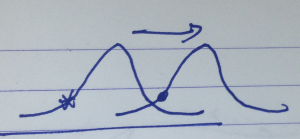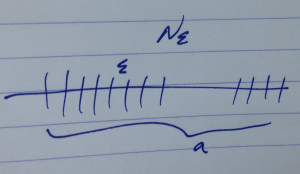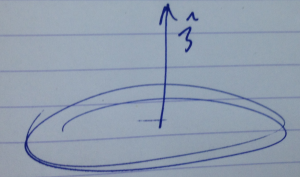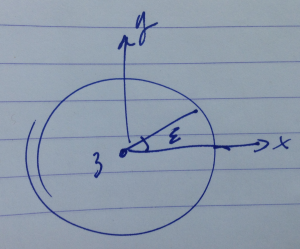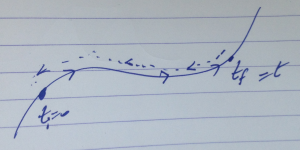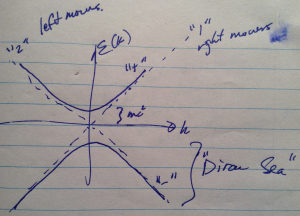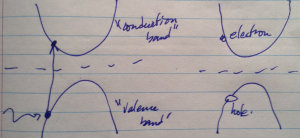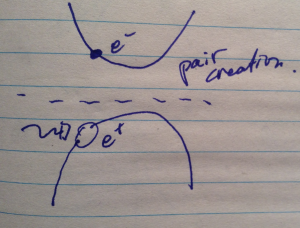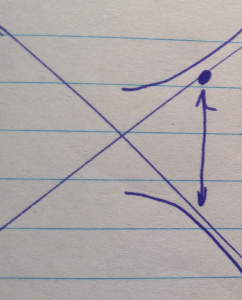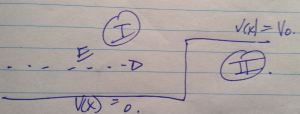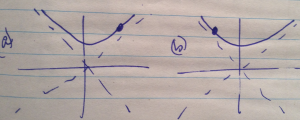[Click here for a PDF of this post with nicer formatting]
Motivation.
The notation I prefer for relativistic geometric algebra uses Hestenes’ space time algebra (STA) [2], where the basis is a four dimensional space \( \setlr{ \gamma_\mu } \), subject to Dirac matrix like relations \( \gamma_\mu \cdot \gamma_\nu = \eta_{\mu \nu} \).
In this formalism a four vector is just the sum of the products of coordinates and basis vectors, for example, using summation convention
\begin{equation}\label{eqn:boostToParavector:160}
x = x^\mu \gamma_\mu.
\end{equation}
The invariant for a four-vector in STA is just the square of that vector
\begin{equation}\label{eqn:boostToParavector:180}
\begin{aligned}
x^2
&= (x^\mu \gamma_\mu) \cdot (x^\nu \gamma_\nu) \\
&= \sum_\mu (x^\mu)^2 (\gamma_\mu)^2 \\
&= (x^0)^2 – \sum_{k = 1}^3 (x^k)^2 \\
&= (ct)^2 – \Bx^2.
\end{aligned}
\end{equation}
Recall that a four-vector is time-like if this squared-length is positive, spacelike if negative, and light-like when zero.
Time-like projections are possible by dotting with the “lab-frame” time like basis vector \( \gamma_0 \)
\begin{equation}\label{eqn:boostToParavector:200}
ct = x \cdot \gamma_0 = x^0,
\end{equation}
and space-like projections are wedges with the same
\begin{equation}\label{eqn:boostToParavector:220}
\Bx = x \cdot \gamma_0 = x^k \sigma_k,
\end{equation}
where sums over Latin indexes \( k \in \setlr{1,2,3} \) are implied, and where the elements \( \sigma_k \)
\begin{equation}\label{eqn:boostToParavector:80}
\sigma_k = \gamma_k \gamma_0.
\end{equation}
which are bivectors in STA, can be viewed as an Euclidean vector basis \( \setlr{ \sigma_k } \).
Rotations in STA involve exponentials of space like bivectors \( \theta = a_{ij} \gamma_i \wedge \gamma_j \)
\begin{equation}\label{eqn:boostToParavector:240}
x’ = e^{ \theta/2 } x e^{ -\theta/2 }.
\end{equation}
Boosts, on the other hand, have exactly the same form, but the exponentials are with respect to space-time bivectors arguments, such as \( \theta = a \wedge \gamma_0 \), where \( a \) is any four-vector.
Observe that both boosts and rotations necessarily conserve the space-time length of a four vector (or any multivector with a scalar square).
\begin{equation}\label{eqn:boostToParavector:260}
\begin{aligned}
\lr{x’}^2
&=
\lr{ e^{ \theta/2 } x e^{ -\theta/2 } } \lr{ e^{ \theta/2 } x e^{ -\theta/2 } } \\
&=
e^{ \theta/2 } x \lr{ e^{ -\theta/2 } e^{ \theta/2 } } x e^{ -\theta/2 } \\
&=
e^{ \theta/2 } x^2 e^{ -\theta/2 } \\
&=
x^2 e^{ \theta/2 } e^{ -\theta/2 } \\
&=
x^2.
\end{aligned}
\end{equation}
Paravectors.
Paravectors, as used by Baylis [1], represent four-vectors using a Euclidean multivector basis \( \setlr{ \Be_\mu } \), where \( \Be_0 = 1 \). The conversion between STA and paravector notation requires only multiplication with the timelike basis vector for the lab frame \( \gamma_0 \)
\begin{equation}\label{eqn:boostToParavector:40}
\begin{aligned}
X
&= x \gamma_0 \\
&= \lr{ x^0 \gamma_0 + x^k \gamma_k } \gamma_0 \\
&= x^0 + x^k \gamma_k \gamma_0 \\
&= x^0 + \Bx \\
&= c t + \Bx,
\end{aligned}
\end{equation}
We need a different structure for the invariant length in paravector form. That invariant length is
\begin{equation}\label{eqn:boostToParavector:280}
\begin{aligned}
x^2
&=
\lr{ \lr{ ct + \Bx } \gamma_0 }
\lr{ \lr{ ct + \Bx } \gamma_0 } \\
&=
\lr{ \lr{ ct + \Bx } \gamma_0 }
\lr{ \gamma_0 \lr{ ct – \Bx } } \\
&=
\lr{ ct + \Bx }
\lr{ ct – \Bx }.
\end{aligned}
\end{equation}
Baylis introduces an involution operator \( \overline{{M}} \) which toggles the sign of any vector or bivector grades of a multivector. For example, if \( M = a + \Ba + I \Bb + I c \), where \( a,c \in \mathbb{R} \) and \( \Ba, \Bb \in \mathbb{R}^3 \) is a multivector with all grades \( 0,1,2,3 \), then the involution of \( M \) is
\begin{equation}\label{eqn:boostToParavector:300}
\overline{{M}} = a – \Ba – I \Bb + I c.
\end{equation}
Utilizing this operator, the invariant length for a paravector \( X \) is \( X \overline{{X}} \).
Let’s consider how boosts and rotations can be expressed in the paravector form. The half angle operator for a boost along the spacelike \( \Bv = v \vcap \) direction has the form
\begin{equation}\label{eqn:boostToParavector:120}
L = e^{ -\vcap \phi/2 },
\end{equation}
\begin{equation}\label{eqn:boostToParavector:140}
\begin{aligned}
X’
&=
c t’ + \Bx’ \\
&=
x’ \gamma_0 \\
&=
L x L^\dagger \\
&=
e^{ -\vcap \phi/2 } x^\mu \gamma_\mu
e^{ \vcap \phi/2 } \gamma_0 \\
&=
e^{ -\vcap \phi/2 } x^\mu \gamma_\mu \gamma_0
e^{ -\vcap \phi/2 } \\
&=
e^{ -\vcap \phi/2 } \lr{ x^0 + \Bx } e^{ -\vcap \phi/2 } \\
&=
L X L.
\end{aligned}
\end{equation}
Because the involution operator toggles the sign of vector grades, it is easy to see that the required invariance is maintained
\begin{equation}\label{eqn:boostToParavector:320}
\begin{aligned}
X’ \overline{{X’}}
&=
L X L
\overline{{ L X L }} \\
&=
L X L
\overline{{ L }} \overline{{ X }} \overline{{ L }} \\
&=
L X \overline{{ X }} \overline{{ L }} \\
&=
X \overline{{ X }} L \overline{{ L }} \\
&=
X \overline{{ X }}.
\end{aligned}
\end{equation}
Let’s explicitly expand the transformation of \ref{eqn:boostToParavector:140}, so we can relate the rapidity angle \( \phi \) to the magnitude of the velocity. This is most easily done by splitting the spacelike component \( \Bx \) of the four vector into its projective and rejective components
\begin{equation}\label{eqn:boostToParavector:340}
\begin{aligned}
\Bx
&= \vcap \vcap \Bx \\
&= \vcap \lr{ \vcap \cdot \Bx + \vcap \wedge \Bx } \\
&= \vcap \lr{ \vcap \cdot \Bx } + \vcap \lr{ \vcap \wedge \Bx } \\
&= \Bx_\parallel + \Bx_\perp.
\end{aligned}
\end{equation}
The exponential
\begin{equation}\label{eqn:boostToParavector:360}
e^{-\vcap \phi/2}
=
\cosh\lr{ \phi/2 }
– \vcap \sinh\lr{ \phi/2 },
\end{equation}
commutes with any scalar grades and with \( \Bx_\parallel \), but anticommutes with \( \Bx_\perp \), so
\begin{equation}\label{eqn:boostToParavector:380}
\begin{aligned}
X’
&=
\lr{ c t + \Bx_\parallel } e^{ -\vcap \phi/2 } e^{ -\vcap \phi/2 }
+
\Bx_\perp e^{ \vcap \phi/2 } e^{ -\vcap \phi/2 } \\
&=
\lr{ c t + \Bx_\parallel } e^{ -\vcap \phi }
+
\Bx_\perp \\
&=
\lr{ c t + \vcap \lr{ \vcap \cdot \Bx } } \lr{ \cosh \phi – \vcap \sinh \phi }
+
\Bx_\perp \\
&=
\Bx_\perp
+
\lr{ c t \cosh\phi – \lr{ \vcap \cdot \Bx} \sinh \phi }
+
\vcap \lr{ \lr{ \vcap \cdot \Bx } \cosh\phi – c t \sinh \phi } \\
&=
\Bx_\perp
+
\cosh\phi \lr{ c t – \lr{ \vcap \cdot \Bx} \tanh \phi }
+
\vcap \cosh\phi \lr{ \vcap \cdot \Bx – c t \tanh \phi }.
\end{aligned}
\end{equation}
Employing the argument from [3],
we want \( \phi \) defined so that this has structure of a Galilean transformation in the limit where \( \phi \rightarrow 0 \). This means we equate
\begin{equation}\label{eqn:boostToParavector:400}
\tanh \phi = \frac{v}{c},
\end{equation}
so that for small \(\phi\)
\begin{equation}\label{eqn:boostToParavector:420}
\Bx’ = \Bx – \Bv t.
\end{equation}
We can solving for \( \sinh^2 \phi \) and \( \cosh^2 \phi \) in terms of \( v/c \) using
\begin{equation}\label{eqn:boostToParavector:440}
\tanh^2 \phi
= \frac{v^2}{c^2}
=
\frac{ \sinh^2 \phi }{1 + \sinh^2 \phi}
=
\frac{ \cosh^2 \phi – 1 }{\cosh^2 \phi}.
\end{equation}
which after picking the positive root required for Galilean equivalence gives
\begin{equation}\label{eqn:boostToParavector:460}
\begin{aligned}
\cosh \phi &= \frac{1}{\sqrt{1 – (\Bv/c)^2}} \equiv \gamma \\
\sinh \phi &= \frac{v/c}{\sqrt{1 – (\Bv/c)^2}} = \gamma v/c.
\end{aligned}
\end{equation}
The Lorentz boost, written out in full is
\begin{equation}\label{eqn:boostToParavector:480}
ct’ + \Bx’
=
\Bx_\perp
+
\gamma \lr{ c t – \frac{\Bv}{c} \cdot \Bx }
+
\gamma \lr{ \vcap \lr{ \vcap \cdot \Bx } – \Bv t }
.
\end{equation}
Authors like Chappelle, et al., that also use paravectors [4], specify the form of the Lorentz transformation for the electromagnetic field, but for that transformation reversion is used instead of involution.
I plan to explore that in a later post, starting from the STA formalism that I already understand, and see if I can make sense
of the underlying rationale.
References
[1] William Baylis. Electrodynamics: a modern geometric approach, volume 17. Springer Science \& Business Media, 2004.
[2] C. Doran and A.N. Lasenby. Geometric algebra for physicists. Cambridge University Press New York, Cambridge, UK, 1st edition, 2003.
[3] L. Landau and E. Lifshitz. The Classical theory of fields. Addison-Wesley, 1951.
[4] James M Chappell, Samuel P Drake, Cameron L Seidel, Lachlan J Gunn, and Derek Abbott. Geometric algebra for electrical and electronic engineers. Proceedings of the IEEE, 102 0(9), 2014.
